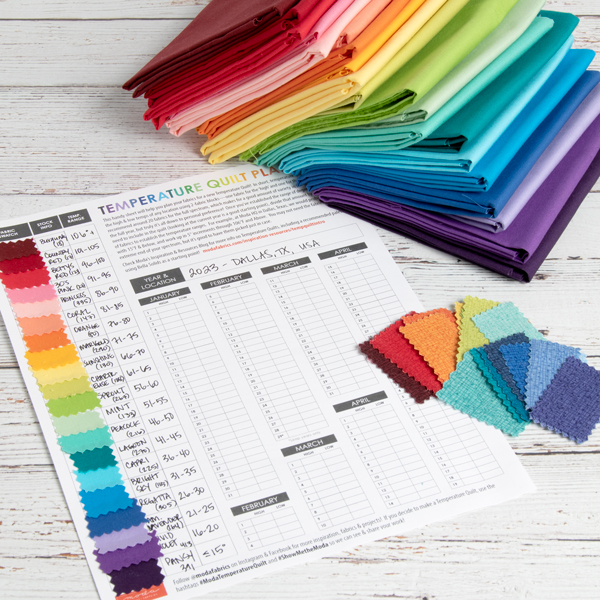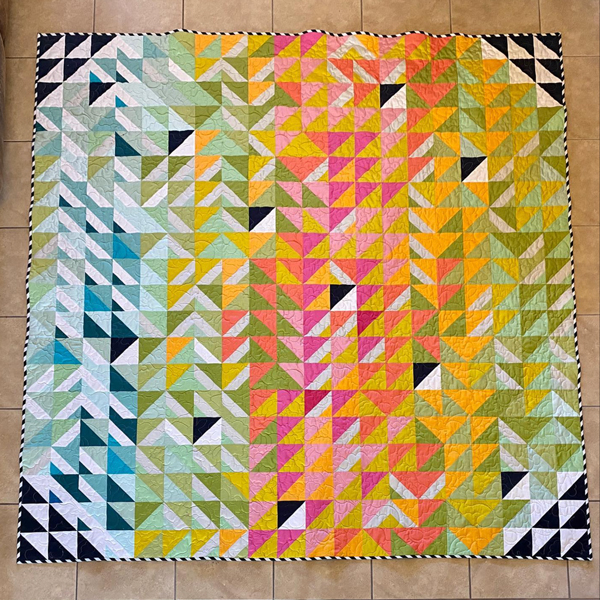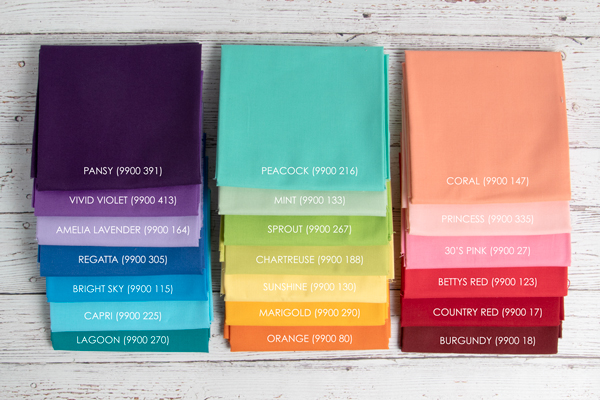Welcome to Moda Fabrics!
Intro to Temperature Quilts
Intro to Temperature Quilts
Have you ever heard of a Temperature Quilt?
Long story short, a temperature quilt uses simple 2-fabric quilt blocks over the course of a whole year (or however long you want) to track the high and low temperatures of each day in a given location. Popular both in quilting and knitting/crochet, temperature quilts are made all around the world representing all different types of climates and milestones totally unique to whoever is making the project.
In this post, we'll share tips on getting started on your own project for 2023, a handy temperature tracker where you can make note of your fabrics being used, inspiration for different types of designs, and more.

DESIGN INSPIRATION
Simply searching Instagram for #TemperatureQuilt comes up with boundless inspiration to get your wheels turning. Here are a few projects we thought showed a variety of styles and ideas for making one of your own.

This quilt by Stephanie Hedstrom @wxninja shows 2019 high and low temperatures in both Omaha, NE (Jan 1-May 31) and Tucson, AZ (June 1-Dec 31). If the high temperature was above normal, the block angles upward, and downward if the high was below normal. The additional strips in the HST's show any precipitation on that day, snow (white) or rain (grey). The black and white HSTs mixed into the quilt are month markers (the ones in the corners are decorative). See additional photos, including the key in her quilt backing, here.

Rebecca Cartwright @rebcartwright made her quilt out of all hexagons split in half between high and low temperatures, using a spectrum of Grunge fabrics set on mixed low volume squares. Check out Rebecca's quilt here.

Jessica Quilter @jessicaquilter used bright flying geese blocks in her 2021 Temperature Quilt. The 'goose' is the high temp, and the background is the low. She even cut up parts of a calendar tea towel to use as month markers through the quilt. All of her geese were foundation pieced, and you'll notice how she's incorporated a fabric key on the left side which has several fabrics she didn't actually need for her 2021 temps. See more info about her quilt here.

Anke @anris_zaubernadel is still working on her project for 2022, but we couldn't resist sharing these gorgeous blocks in progress using Grunges, where you can really see how the foundation piecing helps keep things organized. I can only imagine how having that paper on the back helps with remembering what block is for which day after a few months have passed! See more from Anke here.

This quilt is a great reference for anyone thinking of using colors outside of a traditional 'rainbow' spectrum. Penny @roundstones_and_greenseas made this quilt to show the 2021 temperatures in Eastbourne, Sussex, UK, and the neutral palette clearly fits right in! You can also see how she included letter blocks as markers along the calendar. Read more about Penny's quilt here.
WHERE TO BEGIN
Download Moda's Temperature Quilt Planner here to help you get organized as you start thinking about your 2023 quilt. If you don't get to it in 2023, don't worry--the calendar isn't specific to any year, so you can use it for any year you like!
![]()
Before you sew, you'll need to do the following:
1. Decide how many steps you want and how many degrees will be included in each step. For Moda HQ in Dallas, we looked at the highs and lows for the previous full year: the highest high of 2021 was 108 degrees Fahrenheit, and the lowest low was 18. So that gives us a full spectrum of 90 degrees to cover, and fits nicely into 5 degree increments from 15 degrees & under, to 16-20, 21-25, etc etc all the way up to 106 degrees & above. There's always a chance the weather will swing hotter or colder on either end of the spectrum, so make sure you have as much buffer as you like--knowing you may not end up needing some of the fabrics at either end.
2. Pick your fabrics. The fun part! Many temperature quilts use one fabric line of solids or near-solids because that makes it easy to pick a color spectrum that isn't influenced by any mix of colors in a print, and so that you can clearly see the gradient of temperature changes. However, just as many people go scrappy or use prints--it truly is all up to you and what makes you happy. More on fabric below, where we've pulled a few sample color palettes to get you started. TIP: Make sure to write down the fabric line, color, and/or stock # of your fabrics in case you have to reorder months after you've started!
3. Decide your design. Many (but not all) temperature quilts use one block repeated every day to show the high and low temperature. Things like Half Square Triangles and Flying Geese are perfect for this, but you could do hexies, applique circles, cross blocks, really anything that speaks to you. We've shared a few ideas found through Instagram, but there are countless more possibilities out there. And don't forget to plan for details like month markers, how you may lay out your days, and of course a key/label to share the temperatures you used.
4. Track your temps! Whether you make a temperature quilt block each day, or just track temperatures daily and sew batches later, it will seem less daunting if you can try to keep up with it throughout the year rather than circling back at the end. Did we mention we made a handy quilt planner that includes a temperature tracker for a full year? Download it here!
COLOR PALETTES
In many temperature quilts, you'll find a spectrum of color similar to what we associate with lower and higher temperatures. Purples/Blues/Cool Tones down at the lower temperatures, transitioning up through Oranges/Reds/Warm Tones at the higher temps. Having a steady ombre effect in your color palette creates interesting color interactions over the course of the year where things gradually transition between different degrees. However, there's no rule that says you have to organize your colors this way! If you just love pink, do a whole spectrum of pinks to represent your year! Or if you really want a more limited palette of blues, teals and yellows, just choose colors in that range. It truly is up to you and what speaks to you when thinking about tracking temperatures, and we've put together a couple different palettes to start from if you're thinking about jumping in for 2023.

These Bella Solids make for a bright and cheery rainbow in 20 steps: PANSY (9900 391), VIVID VIOLET (9900 413), AMELIA LAVENDER (9900 164), REGATTA (9900 305), BRIGHT SKY (9900 115), CAPRI (9900 225), LAGOON (9900 270), PEACOCK (9900 216), MINT (9900 133), SPROUT (9900 267), CHARTREUSE (9900 188), SUNSHINE (9900 130), MARIGOLD (9900 290), ORANGE (9900 80), CORAL (9900 147), PRINCESS (9900 335), 30'S PINK (9900 27), BETTYS RED (9900 123), COUNTRY RED (9900 17), BURGUNDY (9900 18)
We couldn't resist pulling a second palette using Thatched by Robin Pickens. Still a rainbow, but an overall more saturated set of 22 colors. As you can see, you can add as many colors as you like to either stretch out your possible temperatures, or to have each color represent fewer ranges of degrees.

THATCHED BY ROBIN PICKENS: DUTCH IRIS (48626 175), PERIWINKLE (48626 174), CORNFLOWER (48626 147), MIST (48626 146), ROYAL (48626 96), NAVY (48626 94), HORIZON (48626 136), TURQUOISE (48626 101), BROOK (48626 198), SEAFOAM (48626 125), GREENERY (48626 124), SPRING (48626 54), MAIZE (48626 28), HONEYCOMB (48626 178), AGED PENNY (48626 180), CITRUS (48626 123), CLEMENTINE (48626 138), SMOKED PAPRIKA (48626 183), CRIMSON (48626 43), SCARLET (48626 119), CRANBERRY (48626 118), BURGUNDY (48626 60)
So what do you think? Are you going to try to make a temperature quilt for 2023? Have you ever made one before? If you have, we'd love to hear any advice you have in the comments. We have a few people in the Moda offices thinking it over and deciding what design choices they want to make and which fabrics to use--so many possibilities! If you end up making one after reading this post, we'd love to see your progress; Post on social media using hashtags #ModaTemperatureQuilt and #ShowMetheModa to share your plans & blocks.
Happy stitching!

Comments